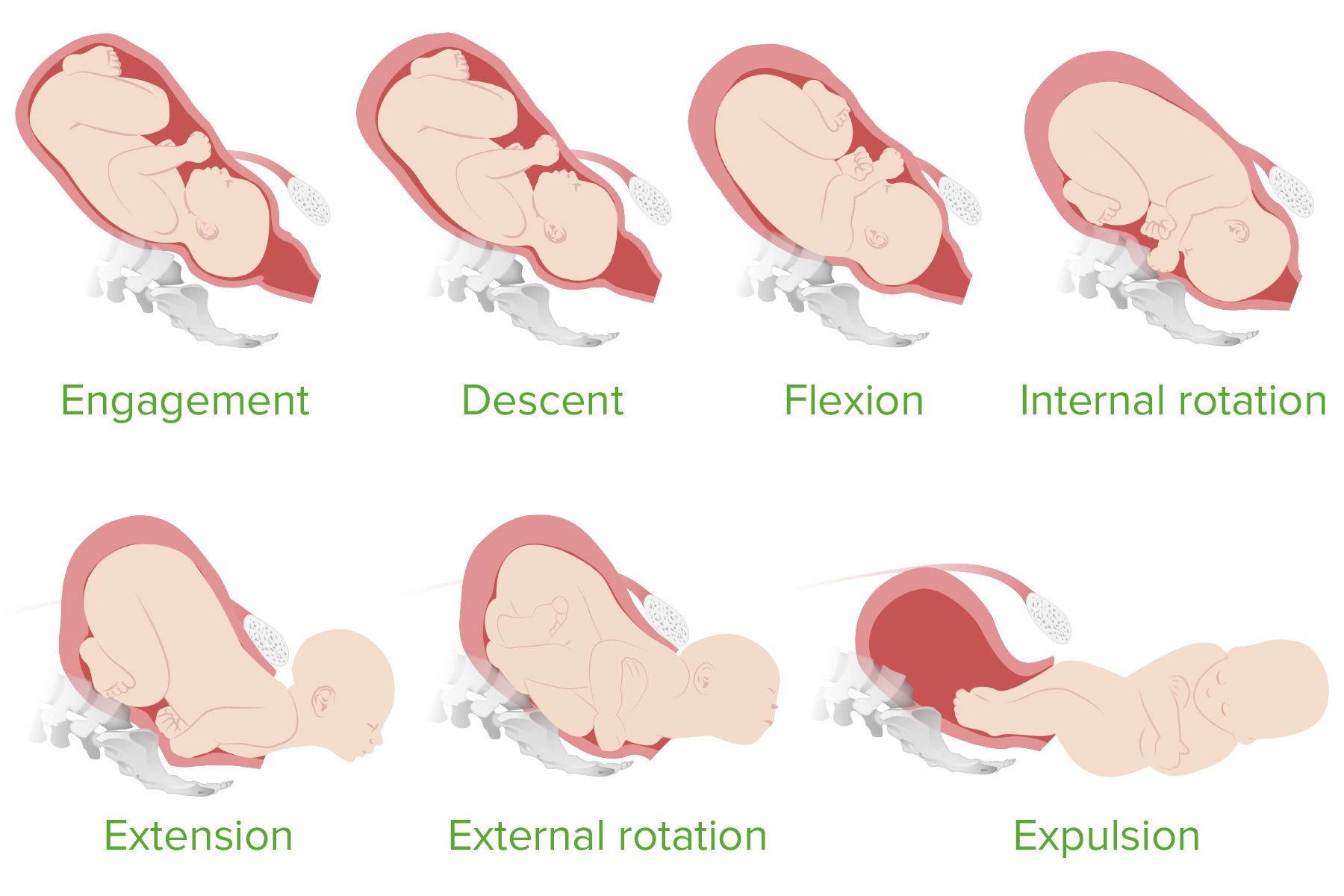
Abnormal labor, clinically termed dystocia, is a critical topic in obstetrics, referring to any slow, difficult, or arrested progression of labor. Timely recognition and specialized management of these patterns are essential to minimize both maternal and neonatal morbidity and mortality.
Defining Abnormal Labor Patterns
Abnormal labor patterns are conventionally defined by deviations from established norms regarding cervical dilation and descent of the fetal presenting part. Historically, the Friedman curve set these standards, though contemporary practice often utilizes revised, more flexible criteria (e.g., ACOG/SMFM guidelines) recognizing that labor progresses more slowly, particularly in the latent phase and the early active phase, than previously thought.
Abnormal labor generally falls into three categories, corresponding to the “3 P’s” of labor mechanics:
- Power (Uterine Contractions): Issues related to hypotonic (weak, infrequent) or hypertonic (uncoordinated, painful) uterine contractions, leading to inadequate force generation for cervical change.
- Passenger (Fetus): Problems related to fetal size (macrosomia), presentation (breech, transverse lie), position (persistent occiput posterior), or anomalies.
- Passage (Pelvis): Inadequacies in the maternal bony pelvis or soft tissues (pelvic shape, tumors) that impede fetal descent.
Specific patterns of dystocia include protraction disorders (labor progressing slowly, often defined by slow cervical dilation or slow fetal descent) and arrest disorders (complete cessation of progressive labor, such as arrest of dilation or arrest of descent).
Etiologies of Abnormal Labor and Risk Factors
The etiology of abnormal labor is complex, involving mechanical limitations, hormonal imbalances, and psychological stressors.
Physiological and Mechanical Etiologies
The primary causes relate directly to the 3 P’s. For instance, uterine inertia (a Power issue) is often multifactorial, potentially linked to high parity, chorioamnionitis, or excessive analgesia. Malpresentation (a Passenger issue) is common in prematurity or cases of placental previa. Cephalopelvic disproportion (CPD) (a Passage issue) involves a mismatch between the fetal head size and the maternal pelvis.
The Role of Social and Environmental Factors
It is crucial to recognize that the risk of developing abnormal labor is significantly modulated by social determinants of health and environmental stressors, reflecting value-based care principles that consider the whole patient context.
- Chronic Stress and Allostatic Load: High levels of chronic stress (due to poverty, systemic racism, or intimate partner violence) can disrupt the delicate hormonal balance governing labor (oxytocin, prostaglandins, catecholamines), potentially leading to uncoordinated or ineffective uterine contractions.
- Access to Care: Lack of consistent prenatal care, particularly in underserved communities, prevents the identification and management of high-risk conditions (e.g., gestational diabetes leading to macrosomia) that predispose women to dystocia.
- Systemic Bias and Intervention: Studies suggest racial and socioeconomic disparities exist in the rates of labor induction, augmentation, and subsequent Cesarean delivery. Implicit bias in care delivery can lead to differential application of protocols, potentially contributing to suboptimal labor management for vulnerable populations.
- Environmental Exposures: Exposure to environmental toxins (e.g., endocrine-disrupting chemicals) may subtly influence uterine contractility or placental function, though this area requires further research.
Evaluation, Diagnosis, and the Role of the Interprofessional Team
Evaluating labor patterns requires continuous, objective assessment by the interprofessional team, primarily nursing professionals and midwives, adhering to value-based care principles—prioritizing patient safety while minimizing unnecessary intervention.
Methods of Evaluation
- Partogram Use: The partogram is a graphical record of labor progression (cervical dilation, fetal descent, uterine activity). It is a vital tool for early identification of protraction or arrest disorders, helping standardize the definition of abnormal labor across different units.
- Uterine Activity Monitoring: Tocodynamometry or intrauterine pressure catheters (IUPC) are used to quantify the frequency, duration, and intensity of contractions (measured in Montevidean Units or MU), ensuring the uterine force is adequate for progression.
- Fetal Surveillance: Continuous or intermittent electronic fetal monitoring (EFM) is essential to detect signs of fetal intolerance to labor, which often accompanies mechanical dystocia.
- Clinical Assessment: Regular, judicious cervical examinations assess dilation, effacement, and the station and position of the fetal head.
Role of Nursing and Midwifery (Value-Based Care)
Nursing staff and midwives are at the bedside and serve as the primary diagnostic screeners for abnormal labor. Their role extends beyond data collection:
- Early Recognition: Identifying subtle deviations on the partogram, recognizing hypertonic contraction patterns that compromise fetal oxygenation, or noting inadequate descent.
- Non-Intervention Strategies: Implementing supportive measures consistent with value-based care, such as position changes, hydrotherapy, mobility, and maternal support, to optimize fetal positioning and uterine contractility before escalation to medical interventions (e.g., oxytocin).
- Advocacy: Ensuring the patient’s preferences and informed consent are central to any decision regarding labor augmentation or surgical delivery.
Fetal and Maternal Complications of Abnormal Labor
Delayed diagnosis or ineffective management of dystocia poses significant risks to both mother and infant.
Fetal Complications
- Fetal Hypoxia/Acidosis: Prolonged labor, especially when accompanied by poorly coordinated uterine contractions or mechanical obstruction, can reduce uteroplacental perfusion, resulting in fetal distress, meconium aspiration, and potentially hypoxic-ischemic encephalopathy (HIE).
- Birth Trauma: Difficult vaginal deliveries necessitated by dystocia (e.g., operative vaginal delivery via forceps or vacuum) increase the risk of fetal injury, including cephalohematoma, brachial plexus injury, and skull fracture.
Maternal Complications
- Infection: Prolonged rupture of membranes and prolonged labor increase the risk of chorioamnionitis and subsequent maternal sepsis.
- Postpartum Hemorrhage (PPH): Uterine overdistension, uterine fatigue, or infection associated with abnormal labor significantly heightens the risk of uterine atony, the leading cause of PPH.
- Uterine Rupture: While rare, this catastrophic complication is particularly associated with obstructed labor or attempts at delivery following prior Cesarean sections (TOLAC).
- Psychological Distress: Protracted and painful labor, often culminating in an emergency Cesarean, increases the risk of maternal postpartum depression and psychological trauma.
Oxytocin Administration: Indications, Contraindications, and Safety
Oxytocin is a synthetic pituitary hormone used commonly in obstetrics for labor induction and augmentation. Its use requires rigorous monitoring due to the potential for uterine hyperstimulation.
Indications for Oxytocin
- Labor Induction: Initiation of uterine contractions before spontaneous onset when the risks of continuing pregnancy outweigh the risks of delivery (e.g., post-term pregnancy, preeclampsia, or fetal growth restriction).
- Labor Augmentation: Stimulation of hypotonic uterine contractions during the active phase of labor when progression has slowed or arrested (a Power issue).
Contraindications for Oxytocin
Oxytocin is contraindicated when vaginal delivery is not safe or feasible, or where there is a high risk of uterine rupture:
- Placenta previa or vasa previa.
- Active genital herpes infection.
- Uterine surgery involving the fundus (classical Cesarean incision).
- Fetal malpresentation (e.g., transverse lie).
- Non-reassuring fetal status confirmed by EFM that requires immediate delivery.
Patient Safety Considerations
The primary risk of oxytocin is uterine tachysystole (excessive uterine contractions) leading to fetal compromise. Safe administration requires:
- Continuous EFM and strict recording of contraction frequency and intensity.
- Starting the infusion at a low dose and increasing gradually based on established protocols.
- Immediate intervention (decreasing/stopping the infusion, administering a tocolytic like terbutaline) if uterine tachysystole or non-reassuring fetal status occurs.
Trial of Labor After Cesarean (TOLAC)
TOLAC is the clinical pathway where a woman with a history of a prior Cesarean delivery attempts a subsequent vaginal birth (Vaginal Birth After Cesarean or VBAC). This decision is highly individualized.
Risks of TOLAC
The most serious risk is uterine rupture along the old surgical scar, which is an obstetric emergency. The risk varies depending on the type of prior incision (low transverse incision is safest) and the number of previous Cesarean deliveries. Uterine rupture can lead to severe maternal hemorrhage and fetal demise or neurological injury.
Benefits of TOLAC
If successful (VBAC), the benefits include:
- Avoidance of major abdominal surgery and its associated complications (infection, hemorrhage, longer recovery time).
- Reduced risk of complications in future pregnancies (placenta previa/accreta, bowel/bladder injury).
- Shorter hospital stay and reduced lifetime healthcare costs.
Emergency Management Strategies
Certain forms of abnormal labor or unexpected events require rapid, coordinated emergency management by a comprehensive interprofessional team (nursing, OB physician, anesthesia, neonatology, surgical staff).
If a true emergency (vaginal delivery of a preterm or undiagnosed breech) occurs, delivery must be managed specifically to prevent head entrapment:
- Action: Immediate mobilization of the team. Allow spontaneous expulsion up to the level of the umbilicus. Avoid traction. Deliver the arms using the Lovset maneuver. Deliver the head using the Mauriceau-Smellie-Veit maneuver or Piper forceps to protect the fetal airway and spine.
- Team Role: Senior OB provider must be present; rapid transfer to the operative suite is ideal.
Shoulder dystocia occurs when the anterior fetal shoulder becomes impacted behind the maternal pubic symphysis after the head has delivered. It is an unpredictable emergency requiring immediate, systematic maneuvers to prevent fetal hypoxia and permanent brachial plexus injury.
- Action: The “HELPERR” mnemonic guides rapid intervention:
- Help (Call for the team).
- Episiotomy (Not always helpful, but creates room).
- Leg hyperflexion (McRoberts maneuver).
- Pressure (Suprapubic pressure).
- Enter the vagina (Internal rotation: Rubin/Wood’s Screw maneuvers).
- Remove the posterior arm.
- Roll the patient (Gaskin maneuver).
- Team Role: Nurses track timing meticulously (dystocia should resolve within 5 minutes) while the attending physician performs maneuvers; anesthesia ensures pain control if operative maneuvers become necessary.
3. Cord Prolapse
Cord prolapse occurs when the umbilical cord descends past the fetal presenting part and into the cervix or vagina, causing acute occlusion and fetal distress.
- Action: Immediate relief of cord pressure. The examiner must digitally elevate the presenting fetal part (often the head) off the cord via the vagina and maintain this pressure while simultaneously preparing for immediate Cesarean delivery. Trendelenburg position or knee-chest position can assist.
- Team Role: Rapid communication is vital. Nursing immediately prepares the operating room and notifies anesthesia and neonatology. The primary concern is maintaining continuous digital pressure on the presenting part until the fetus is delivered surgically.
References
- American College of Obstetricians and Gynecologists (ACOG). (2014). Safe Prevention of the Primary Cesarean Delivery. Practice Bulletin No. 136.
- American College of Obstetricians and Gynecologists (ACOG). (2019). Vaginal Birth After Cesarean Delivery. Practice Bulletin No. 205.
- Dennen, P. M., & Eden, V. R. (Eds.). (2017). Dystocia and Abnormal Labor. In Williams Obstetrics (25th ed.). McGraw-Hill Education.
- Grobman, W. A., et al. (2018). Contemporary Management of Labor and Delivery. New England Journal of Medicine, 379(10), 937–946.
- Kilpatrick, S. J., & Garrison, E. (2019). Normal and Abnormal Labor. In Creasy and Resnik’s Maternal-Fetal Medicine: Principles and Practice (8th ed.). Elsevier.






